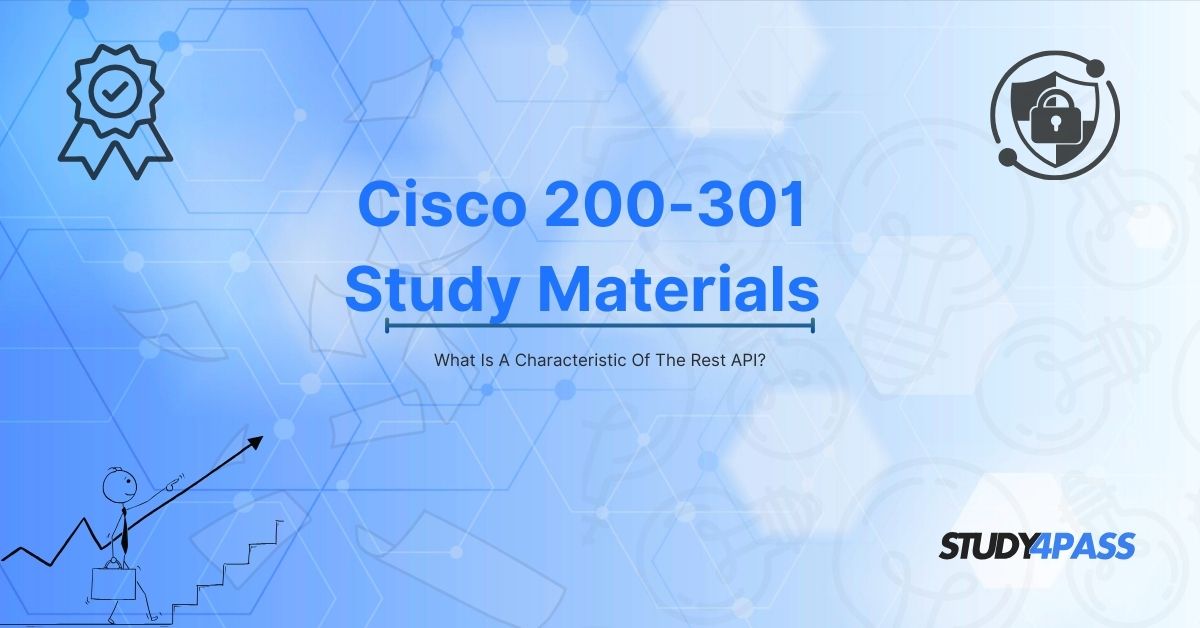Introduction to API Characteristic (ENSA v7.0)
In today's interconnected digital world, REST APIs (Representational State Transfer Application Programming Interfaces) play a crucial role in enabling communication between different software systems. For IT professionals preparing for the CCNA (200-301)-(ENSA v7.0) certification exam, understanding REST API characteristics is essential, as modern networking increasingly relies on API-driven automation and cloud integration.
This article explores the key characteristics of REST APIs, their relevance in the CCNA 200-301 and ENSA v7.0 exams, and how Study4Pass provides the best study materials to help candidates excel.
What Is a REST API?
A REST API is an architectural style for designing networked applications. It uses HTTP/HTTPS protocols to facilitate communication between clients and servers. REST APIs are stateless, scalable, and cacheable, making them ideal for web services, cloud computing, and network automation—topics covered in the CCNA 200-301 and ENSA v7.0 exams.
Key Characteristics of REST API
Understanding the defining features of REST APIs helps in grasping their role in modern networking and software development. Below are the core characteristics:
1. Statelessness
- Each HTTP request from a client to a server must contain all the necessary information to process the request.
- The server does not store any session data between requests, improving scalability and reliability.
- Exam Relevance: Statelessness aligns with modern cloud architectures and microservices, a key topic in CCNA 200-301.
2. Client-Server Architecture
- REST APIs enforce a separation of concerns between the client (user interface) and the server (data storage and processing).
- This improves portability and scalability, allowing independent evolution of client and server components.
- Exam Relevance: Understanding client-server models is fundamental for network engineers.
3. Cacheability
- REST APIs support caching, where frequently accessed data is stored temporarily to reduce server load and improve performance.
- HTTP headers like Cache-Control and Expires manage caching behavior.
- Exam Relevance: Caching mechanisms are essential for optimizing network performance, a key CCNA topic.
4. Uniform Interface
- REST APIs follow a standardized interaction model with four key principles:
- Resource Identification in Requests (URI) – Each resource has a unique identifier (e.g., https://api.example.com/users).
- Resource Manipulation Through Representations – Clients interact using JSON or XML.
- Self-descriptive Messages – Each request contains enough context to be processed.
- Hypermedia as the Engine of Application State (HATEOAS) – APIs provide links to related resources.
- Exam Relevance: Uniform interfaces simplify API integration, a skill tested in ENSA v7.0.
5. Layered System
- REST APIs can operate through multiple layers (e.g., load balancers, security layers, proxy servers) without the client knowing the underlying architecture.
- Enhances security, scalability, and performance.
- Exam Relevance: Layered security models are crucial in network design (CCNA Security topics).
6. Code on Demand (Optional)
- Servers can temporarily extend client functionality by sending executable code (e.g., JavaScript).
- Though optional, this feature enhances flexibility in web applications.
REST APIs in the CCNA (200-301)-(ENSA v7.0) Exam
The CCNA 200-301 and ENSA v7.0 exams cover network automation, cloud integration, and API-driven networking. Key areas where REST APIs are relevant include:
1. Network Automation & Programmability
- Modern networks use REST APIs for automating configurations (e.g., Cisco DNA Center, SDN controllers).
- Candidates must understand API calls, JSON/XML data formats, and HTTP methods (GET, POST, PUT, DELETE).
2. Cloud Computing & Microservices
- Cloud platforms (AWS, Azure) rely on REST APIs for service integration.
- CCNA 200-301 tests knowledge of cloud networking, where APIs play a critical role.
3. Security & Authentication
- REST APIs use OAuth, API keys, and HTTPS for secure communication.
- ENSA v7.0 emphasizes API security in enterprise networks.
How Study4Pass Helps You Master REST APIs for CCNA (200-301)-(ENSA v7.0)?
Preparing for the CCNA 200-301 and ENSA v7.0 exams requires high-quality study materials that simplify complex topics like REST APIs. Study4Pass offers the best resources, including:
1. Comprehensive Study Guides
- Detailed explanations of REST API principles, HTTP methods, and JSON/XML structures.
- Real-world examples to reinforce learning.
2. Practice Exams & Quizzes
- Simulated test questions on API-driven networking, automation, and cloud integration.
- Instant feedback to identify weak areas.
3. Video Tutorials & Hands-On Labs
- Step-by-step guides on making API calls, configuring network automation, and troubleshooting.
- Practical labs to apply theoretical knowledge.
4. Up-to-Date Content Aligned with Exam Objectives
- Study4Pass ensures all Cisco materials reflect the latest Cisco CCNA 200-301 and ENSA v7.0 syllabus.
5. 24/7 Expert Support
- Access to networking professionals for doubt resolution.
By choosing Study4Pass, candidates gain a competitive edge in mastering REST APIs and other critical exam topics.
Final Thoughts
REST APIs are a fundamental component of modern networking, enabling automation, cloud integration, and efficient communication between systems. For CCNA 200-301 and ENSA v7.0 aspirants, understanding their statelessness, cacheability, uniform interface, and security aspects is crucial.
Study4Pass provides top-tier study materials, practice tests, and expert guidance to ensure exam success. With a structured learning approach, candidates can confidently tackle REST API-related questions and excel in their certification journey.
Start your preparation today with Study4Pass and take the first step toward becoming a Cisco-certified networking professional!
Special Discount: Offer Valid For Limited Time “CCNA 200-301 Prep Materials”
Sample Questions for Cisco 200-301 Test
Actual exam question from Cisco's 200-301 Exam Guide.
1. Which of the following is a key characteristic of REST API?
A) Stateful communication
B) Uses only XML for data exchange
C) Stateless architecture
D) Requires SOAP protocol
2. REST APIs typically use which protocol for communication?
A) FTP
B) HTTP/HTTPS
C) SMTP
D) TCP/IP
3. What does REST stand for in REST API?
A) Remote Execution of System Tasks
B) Representational State Transfer
C) Resource Exchange Standard Technology
D) Rapid Endpoint Service Transfer
4. Which HTTP method is used in REST API to retrieve data?
A) POST
B) PUT
C) GET
D) DELETE
5. REST APIs are designed to be:
A) Tightly coupled with clients
B) Platform and language-dependent
C) Loosely coupled and scalable
D) Only usable with JavaScript


